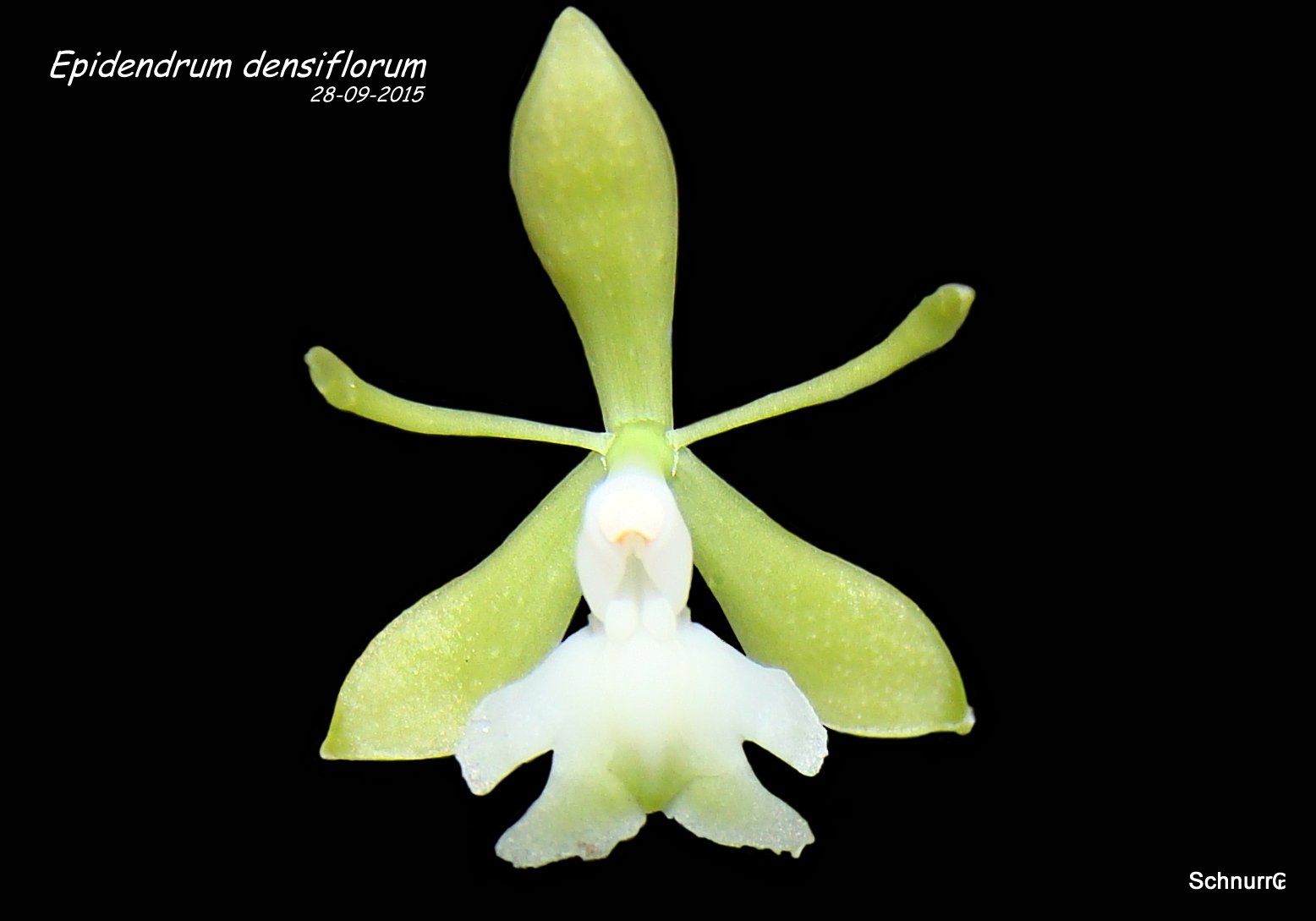

Epidendrum densiflorum Hooker 1840 GROUP Pseudepidendrum SUBGROUP Densiflorum
Photo by © E Schnurr
Photo by © Lourens Grobler
Drawing by Jimenez/Photo by © M R Cabral and Icones Orchidacearum 14 Plate 1423 Hagsater 2013




Common Name The Densely Flowered Epidendrum
Flower Size 1" [2.5 cm]
Found in Venezuela, French Guiana, Guyana, Surinam and Brazil in rainforests at elevations of 500 meters to 2450 meters as a medium to large sized, warm to cold growing epiphyte or terrestrial with erect, cane-like stems enveloped completely by leafless in the lower half and leaf-bearing in the upper half each carrying distichous, elliptic, basally clasping leaves that blooms in the fall on a terminal, paniculate, 12" [30 cm] long, many flowered inflorescence with large bracts at the branch bases
The plant above in the photo is a segregate from the GROUP Pseudepidendrum SUBGROUP Densiflorum and differs by it's large panicle, concave lip blade, small acute apical lobes and the 4 parallel lamellae of the callus extending down the mid-line to the apex of the lip.
"Epidendrum densiflorum belongs to the GROUP Pseudepidendrum which is characterized by caespitose plants, cane-like stems, acute to acuminate leaves, usually apical inflorescence, without any spathaceous bract, though it may have several bracts, the mostly filiform petals and the lip usually 3-lobed (with 3 parallel fleshy keels), the apical lobe often bifurcate, the “bird-wing” type pollinia, at least the inner pair, and Pseudepidendrum SUBGROUP Densiflorumum where the short-pedunculate inflorescence is paniculate, flowering only once, flowers are green, the apex of the column and disc of the lip creamy-white, the calli sometimes tinged purple, the petals are linear-oblong to linear-oblanceolate, never filiform, and the pollinia unequal in shape, only the inner pair “bird-wing” like. The species is recognized by the tall, robust stems, dense inflorescences with up to 250, relatively small greenish brown flowers, the lip white, sepals .4 to .52" [10 to 13 mm] long, the lip slightly 3-lobed with the lateral lobes sub-quadrate-dolabriform, the mid-lobe short and forming a pair of obliquely triangular, acute lobes. Epidendrum noackii Cogn. has very thin stems, inflorescences short and few-flowered, racemose to few-branched-paniculate, sepals .52" [13 mm] long and the lip wider between the lateral-lobes than between the lobes of the mid-lobe. Epidendrum hassleri Cogn. has many-flowered, lax inflorescences, the lip clearly 3- lobed, with the mid-lobe forming a pair of linear lobes. Epidendrum andres-johnsonii Hágsater & E.Santiago has a lax, fewer-flowered inflorescence carrying 40 to 50 flowers, with somewhat narrower leaves .52 to 1.1" [1.3 to 2.9 cm] wide and the column .36 to .427" [9 to 10.7 mm] long. Epidendrum lindbergii Rchb.f. though confused with this species has a spathe and wider petals and thus belongs to the SUBGROUP Viridipurpureum , and has .4" [10 mm] long sepals, wide, petals oblanceolate-spatulate, .4 x .12" [10 x 3 mm], an entire lip, reniform with the base deeply cordate, and the apex widely emarginate and a pair of short incisions on the sides so as to suggest an incipient, short midlobe. Epidendrum dipus Lindl. has a pair of very prominent spathes at the base of the inflorescence, which is paniculate and carries fewer flowers, petals narrowly spatulate, lip clearly 3-lobed with the mid-lobe slightly narrower than the width between the lateral lobes. Epidendrum nutans Sw., endemic to Jamaica, has a clearly 3-lobed lip with the mid-lobe much narrower than the width between the lateral lobes, emarginate and forming a pair of small triangular lobes." Hagsater etal 2013
Synonyms Epidendrum polyanthum var. densiflorum (Hook.) Lindl. 1853
References W3 Tropicos, Kew Monocot list , IPNI ; Die Orchideen Schlechter 1915; Venezuelan Orchids Illustrated Vol 2 Dunsterville & Garay 1961 not = D densiflorum drawing fide; Die Orchideen 3 Auflage Bd 1 Sonderabdruck aus Schlechter Lieferung 9 513 - 576 Brieger, Maatsch and Senghas 1977 photo fide; Bot Notiser 130 Lojtnant 1977; Orchids of Venezuela, An Illustrated Field Guide Vol 1 Dunsterville & Garay 1979 drawing fide; Icones Planetarun Tropicarum Plate 376 Dodson 1980 drawing fide; The Orchids of Surinam Werkhoven 1986 photo ok; Icones Orchidacearum 3 Plate 382 Hagsater, Sanchez & Garcia-Cruz 1999 see recognition section; Orchids of Venezuela [An illustrated field guide] Vol. 1 Ramiro and Carnevali 2000 drawing fide; Botanica's Orchids Laurel Glen 2002 photo fide; Orquideas Nativas del Tachira Cesar Fernandez 2003 photo fide; Flora of the Venezuelan Guayana Vol 7 Steyermark, Berry, Yatskievych and Holst 2003; Orquideologia 24: 3 Ortiz & Hagsater 2005; Boletim CAOB No 72 2008 photo fide; Orquideas de Roirama Luz & Franco 2012 photo good; Orchids of French Guiana Szlachetko, Veyret, etal 2012 drawing/photo fide; Icones Orchidacearum 14 Plate 1408 Hagsater & Santiago 2013 See recognition section; Icones Orchidacearum 14 Plate 1413 Hagsater & Santiago 2013 See recognition section; Icones Orchidacearum 14 Plate 1423 Hagsater & Sanchez 2013 drawing/photo fide; Icones Orchidacearum 14 Plate 1436 Hagsater & Santiago 2013 See recognition section; Icones Orchidacearum 14 Plate 1450 Hagsater & Sanchez 2013 see recognition section; Icones Orchidacearum 14 Plate 1462 Hagsater & Sanchez 2013 see recognition section; Orchidees du Bresil As Orquideas da Serra Do Castello Vol 3 Chiron & Bolsanello 2013 Drawing/photo fide
--------------------------------------------------------------------------------------------------------------------------